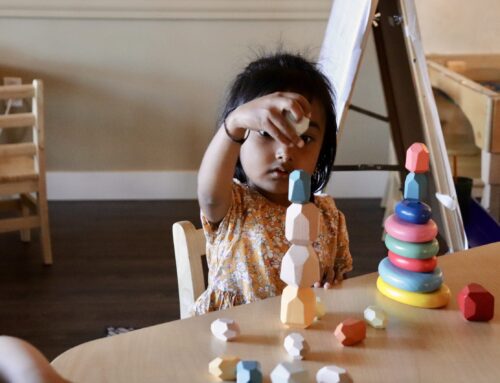During our first open house of the year, I had an interesting exchange with a parent who was wondering what they should be doing with their three-year-old to make sure she would be ready for the learning of school. Should she be doing pre-phonics work? What math skills were we expecting her to have if she joined our school this upcoming fall? The parent wanted to make sure that she was pushing her daughter hard enough at this young age to begin academic mastery. What should they as parents be doing in order to set their child up for success? These are concerns that often bubble up from parents of young children.
Founded in a fear of falling behind — these concerns represent the hierarchy of knowledge that we associate with clearly definable skills. Worksheets and apps at young ages might pass time and prove something is being done, but they don’t give children access to the deeper thinking and learning that will shape the way they approach school and learning. In fact, they might put kids off of school and learning altogether because they reinforce rote and stifling ways of knowing.
There is one thing parents can do to be sure their child is not left behind. Read. Read engaging books. Read sophisticated stories. Read grocery lists and food labels. Read signs and magazines. Read texts with complicated illustrations. Read everything out loud and tell exciting new stories while you’re at it.

As literacy educators Edna Brabham and Carol Lynch-Brown (2002) point out in discussing reading in the classroom.
Reading aloud has been a cornerstone of literacy development and classroom practice for over a century. Listening to stories, children learn about relationships between print and speech, oral and written registers, and nonstandard and standard forms of language. Reading aloud also serves as a primary transmitter of cultural capital and gives students access to cultural literacy regardless of reading ability or exposure to language and books in the home and community (p. 465).
Although reading with your child might seem like an everyday part of your time together, Brabham and Lynch-Brown point out a defining feature of a literacy practice with young children. It’s not so much about reading itself as how you are reading. It’s a lesson that is as useful to teachers as it is for families.
In their study of reading styles in the classroom, Brabham and Lynch-Brown broke down reading into three methods: just reading, performance reading, and interactional reading. Just reading is just what it sounds like. Performance reading encompasses the use of interesting voices and dramatic tactics throughout an uninterrupted reading. Interactional reading includes engaging voice work as well as discussion throughout a text investigating narrative, vocabulary, themes, illustrations, and children’s questions.
Performative and interactional styles also bracket the reading of a text with engaging questions. “What do you notice about the characters on the cover of this book? Who is looking at who? Where do you think they might be going? Can you make a sound for the feeling you think they’re having? Tell me about another time you’ve seen a black cat. What are they thinking about? What might happen next? Where would you end up if you crawled through a magic tunnel? Tell me about an adventure you went on a friend with.”
The researchers looked at 246 students in early elementary classrooms who had pre-service teachers read them specific, informational books with one of the three chosen methods. With an eye on children’s understanding and integration of specific vocabulary from the text, researchers discovered that the way a text is shared with children has an impact.
Brabham and Lynch-Brown write that “Just reading produced the smallest vocabulary gains with greater gains for performance reading and the greatest gains for interactional reading” (p. 470). I bet the pre-service teachers reading expressively with pauses for conversation and dissection found themselves the most engaged, too.
If you are also finding yourself wondering about the best ways to set your child up for success, consider interactional reading to be a foundational element. It’s an open invitation for ongoing dialogue with your child before, during, and after reading a book or any piece of text. You will be bolstering their literacy development through vocabulary acquisition and, equally importantly, you will be building connections for dialogue and big questions in your relationship.

Consider finding texts that give you both something to talk about. Start a new shelf in your home with books that have won The New York Times/New York Public Library Best Illustrated Children’s Books Award. From this year’s list, I’ve particularly fallen in love with Just Because written by Mac Barnett and illustrated by Isabelle Arsenault. It’s illustrations and text work in tandem with the ways in which children think and dream. While you’re at it, check out Another written and illustrated by Christian Robinson. It’s an open-ended fantastical journey that you and your child can create narration and dialogue for as you turn the pages together. Both of these books create opportunities for you to model curiosity for your child by wondering out loud and asking open-ended questions.
Whether it’s with one of these captivating books or the labels in the grocery store, finding ways to expressively read and ask intriguing questions with your child will set them up to be passionate, articulate learners who are excited to ask and think into fascinating questions.
Check out the full article here
Brabham, E. G., & Lynch-Brown, C. (2002). Effects of teachers reading-aloud styles on vocabulary acquisition and comprehension of students in the early elementary grades. Journal of Educational Psychology, 94(3), 465–473. doi: 10.1037/0022-0663.94.3.465







